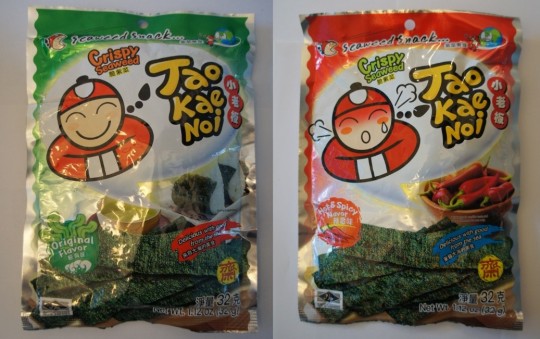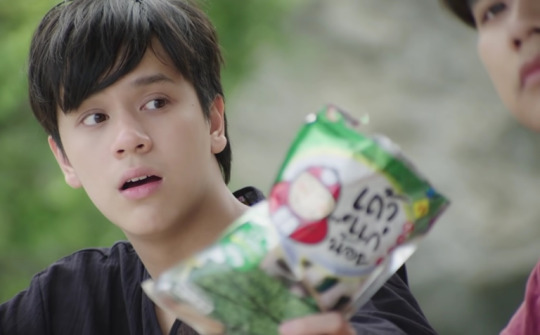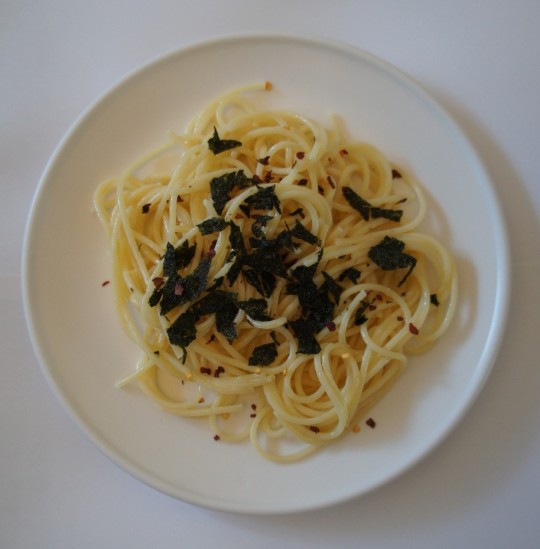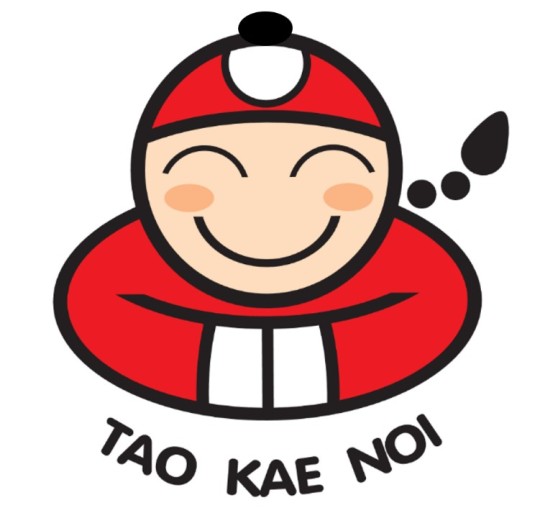#READY FOR PATPRAN TO DOMINATE
Explore tagged Tumblr posts
Text
BAD BUDDY – THOUGHTS ON TAO KAE NOI AND TRANSBOUNDARY CULTURAL MIXING (PLUS A BONUS 10-MINUTE RECIPE)

So I never thought I'd turn into one of those fans who actually goes out and buys the products promoted in Thai BLs – but after getting Pran's PP bag (see this write-up here) I went on to try the ubiquitous crispy seaweed that keeps popping up in GMMTV's Thai BL dramas (very memorably in Bad Buddy at Ep.6 [4/4] 8.45 and Ep.11 [3I4] 6.24).


This write-up was inspired by a post from @luthienmpl, reblogged by @non-binarypal7, linked here.
I tried both the Original Flavor as well as the Hot and Spicy versions of Tao Kae Noi, and they are DEEELICIOUS. They taste kind of like a cross between Japanese nori and Malaysian/Indonesian fish keropok/krupuk (kropek in the Philippines), although you do have to be OK with seafood-type flavors to appreciate this snack. The H&S TKN is also quite mild so the chilli-averse shouldn't be put off (caveat: my chilli tolerance is pretty high, so care befull chilli virgins).
I'm not big on snacking though, so was thinking of other ways to use up my stash (overbought a bit; thinking about PatPran while grocery shopping will do that to you 😊). And came up with this: a 3-ingredient, storecupboard staple lunch, ready in 10 minutes.

Pasta with Tao Kae Noi, somewhat like aglio olio, but with even more of an umami kick from the seaweed. And it was delicious too. 😊👌 Gonna be on my meal rotation from now on! Recipe linked here if you're interested.
But TKN nourishes the mind and soul as well as the body (bear with me on this one 😊). This multicultural snack is also quite the metaphor for intercultural exchange in the 21st century, both in Thailand and on a more global scale.
Before BBS I was used to thinking of Thailand as a cultural monolith, where (almost) everybody is of Thai ethnicity (except for the Malay-dominated southern provinces), similar to the way Japan likes to think of itself. While it's true that Thai culture and the Thai language are population unifiers in the country, Bad Buddy has made me realize that the situation is more nuanced than I had originally thought. Below the surface, there are hints of a more heterogenous cultural history. Just look at Bad Buddy itself – Nanon is part-Vietnamese, Ohm is Thai-Chinese, Drake is half white American, Love Pattranite is part-Japanese, while Milk Pansa has four ethnicities mixed in (Thai, Mon, Chinese and Danish – see the YouTube video linked here, timestamp 7.06). And Director Backaof's late father was given a Catholic funeral (if I remember his Twitter/Instagram postings correctly). Meanwhile, the names Pat and Pran are Indic in origin while Ming is a staunch Chinese traditionalist (written up here). And it's hinted that Dissaya has Middle Eastern (or maybe Indian?) roots (Ep.10 [3I4] 8.05).
Historical reach, relative stability (due to military dominance in the region) and economic prosperity attracted many different peoples to the old kingdom of Siam, and the descendants of most who settled there eventually adopted Thai ways, Thai names and Thai culture. The welcoming nature of the Thai people as well as the Land of Smiles' popularity as a travel destination also mean the demographic mixing continues to this day.
Tao Kae Noi's product, branding and history actually reflect this freewheeling multicultural swirl.

The words Tao Kae Noi (เถ้าแก่น้อย) roughly translate to Little Boss, and Tao Kae Noi was the nickname of the brand's Thai-Chinese founder Tob Itthipat Peeradechapan when he was a kid. (He's still relatively young for a billionaire – 37 as at mid-2022.)
The Tao Kae part is a linguistic loan derived from the Chinese words 頭家, pronounced in the Teochew dialect (which is the predominant Chinese dialect group in Thailand, especially around Bangkok – the language is no longer much spoken among the younger generation though). Tao Kae roughly means (Chinese) Boss, Businessman or Tycoon, and variations of this can be found across Southeast Asia – spelt towkay/taukeh/tauke in Singapore, Malaysia and Indonesia (although these are more probably borrowed from the closely-related Hokkien dialect) – and reflect immigrant Chinese populations' prominence in the commerce of the region.
The Noi part is a Thai diminutive signifier, and Tob Itthipat was called Little Boss because his father was the (big) boss of a wealthy family business. The Chinese words on the Tao Kae Noi packaging also mean Little Boss (小老板, xiao laoban in hanyu pinyin) but this is more the modern-day Mandarin rendition, using totally different words.
The link with Chinese identity is why the cartoon character used for TKN's branding is dressed in Chinese robes with a Chinese pigtail:

Ironically, the Chinese pigtail or queue was not originally a Han Chinese hairstyle. It was imposed upon the subjugated Han by the ruling Manchus during the Qing Dynasty, and the hairstyle consisted of both the queue as well as a shaved forehead. Interestingly, it was the shaved forehead that was more objected to at first (historically Chinese men had always kept their hair long anyway, so the queue was just a plaited step away), but for fear of reprisals (execution being the ultimate) most Han men complied with the enforced hairdo. Old photographs/drawings of Qing-era Chinese men in Southeast Asia also show that the queue was commonly sported, falling out of favor only after the Qing emperor Puyi cut his off in 1922.
But the product Tao Kae Noi isn't traditionally Chinese or Thai (despite the packaging, and the availability of flavors like Tom Yum Goong and Mala). Seaweed as a food isn't unheard of in Southeast Asia – vegan gelatin (agar jelly) is well-known as an ingredient in the region, and the word agar itself is derived from the Malay name for the product agar-agar; another example is the ingredient gamet in the north of the Philippines. But Tao Kae Noi has only been around since 2004 and was actually based on traditional Japanese nori and/or Korean gim, given an international twist with flavors as wide-ranging as Sour Cream and Onion, Japanese Sauce (whatever that is – teriyaki maybe?), Wasabi, as well as the aforementioned Tom Yum Goong and Mala.
And exploring Tao Kae Noi's multicultural roots really takes a turn for the sweetly weird when we look at the history of nori itself.
Nori as a food has been known in Japan for more than a thousand years, first consumed in the form of a paste before papermaking techniques were applied to create the thin sheets so well-known today.
However, the Japanese nori industry began to flounder in the years following World War II. Traditional methods of cultivation had always been beset by fickle yields, mainly because the marine life cycle of nori algae (a complex three-stage process involving host mollusc shells at one point) was poorly understood. The war pushed this situation over the brink – American explosives targeting Japanese ports also devastated shellfish beds crucial to one stage of the algae's life cycle, and the crop all but disappeared in 1948. The nori industry was in danger of dying out.
It was the work by English phycologist Kathleen Mary Drew-Baker on the seaweed harvested to make Welsh laverbread (bara lafwr or bara lawr in Welsh) that provided the breakthrough, on the other side of the world, for the future of nori.

(above) Kathleen Mary Drew-Baker
Kathleen Mary Drew-Baker never went to Japan, but her revolutionary findings about British seaweed were instrumental in leading Japanese researchers (Sokichi Segawa, Fusao Ota and others) to discover more successful methods for the cultivation of nori, based on a better understanding of the algae's life cycle needs. This turn of events ultimately saved the future of this traditional food industry. Kathleen Mary Drew-Baker was dubbed Mother of the Sea by grateful Japanese people, and she is celebrated in Uto City every April 14th when coastal seaweed harvesters take the day off to commemorate her rescue of their livelihood and this thousand-year old ingredient of Japanese cuisine. 😊 There is even a shrine dedicated to her there (👀 I kid you not), that's how esteemed her contribution is.

Photo credit of the Sumiyoshi shrine to Kathleen Mary Drew-Baker: Simasakon (link to the Wikimedia Commons license here), file is unchanged from original
For more info, there's a fascinating article on Kathleen Mary Drew-Baker by the Smithsonian Institution linked here.
So when members of the Bad Buddy fandom watch part-Vietnamese Nanon as Pran and Thai-Chinese Ohm as Pat munch their way through sheets of Tao Kae Noi, or if you happen to cook a plate of Italian/Japanese/Korean-inspired pasta sprinkled with TKN, at the same time the cultural backstory of this product is tugging away at unseen historical links to elements as disparate as Southeast Asian immigration, Chinese hairstyles, Japanese cuisine, British phycology, Welsh algal reproduction and the veneration of a pioneering mid-20th century female English scientist by seaweed harvesters in Kumamoto prefecture. 😊
Can there be a more appropriate metaphor for the transboundary nature of Thai BL fandom today? Thanks to the global reach of the Internet, there are avid viewers in all inhabited continents; the Bad Buddy comments section on YouTube – with posts in Turkish, Arabic, Hindi, French, Spanish, Portuguese, Italian, Russian, Vietnamese, Thai, Tagalog, Burmese, Chinese, Korean, Japanese, Malay/Indonesian among others – shows that the viewership is truly diverse. There are fans from places as far away as South America and as culturally vast (and varied) as Africa and India. And this kind of global diversity coming together over a shared common interest (quaint, charming, sometimes disquieting Thai BL) truly warms my heart. 💖
So excuse me while I take a break to go munch on some Tao Kae Noi right now. I'm feeling the fuzzies again, and I think that's just the right mood for watching PatPran on their Kazz Award-winning Ep.12 [4/4] tin can call across the Jindapat/Siridechawat boundary line (award reference explained here), while I nibble on the seaweed they so love (and that I do too). 😊💖👍

53 notes
·
View notes